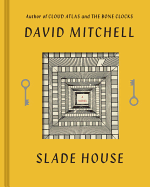
| Publisher: | Random House | |
| Genre: | Supernatural, Fiction, Ghost, Thrillers, Literary | |
| ISBN: | 9780812998689 | |
| Pub Date: | October 2015 | |
| Price: | $26 |
| Starred | Fiction |
by David Mitchell
David Mitchell, well known for strange and distinct novels like The Bone Clocks, offers Slade House as a story of a haunting. The book's brevity may invite comparisons with Henry James's classic novella The Turn of the Screw, but its cyclical, time-hopping, plot-dense structure is pure David Mitchell.
The story begins in 1979, as a possibly autistic boy named Nathan accompanies his mother to a strange house filled with upper-crust English partygoers. Their visit takes a turn for the worse as the house starts to reveal its surreal nature, and Nathan eventually finds himself introduced to the (literally) soul-sucking twins who serve as the antagonists in the novel. Four more chapters introduce four new main characters to the house and its constantly morphing inhabitants at an interval of nine years. Slade House finds its horror in the plot's repetition, summoning up a helpless feeling of inevitability fended off only by its slight variations in each chapter and Mitchell's devilish wit.
Each new character becomes well rounded and familiar in a short amount of time thanks to Mitchell's fantastically nimble first-person narration. Mitchell is the rare kind of genius who can insert what amounts to a thesis statement into the mouth of a character without violating that character's integrity. It's exactly the sort of neat trick that Mitchell fans have been raving about for years, and with good reason. Cliché or no, Slade House reinforces the notion that there really is no one out there like David Mitchell. --Hank Stephenson, bookseller, Flyleaf Books
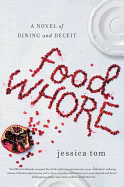
| Publisher: | Morrow | |
| Genre: | Fiction, Coming of Age, Contemporary Women | |
| ISBN: | 9780062387004 | |
| Pub Date: | October 2015 | |
| Price: | $14.99 |
| Fiction |
by Jessica Tom
In Jessica Tom's first novel, Food Whore, her experience as a restaurant reviewer for the Yale Daily News Magazine and her work with food truck, restaurant and culinary program initiatives is put to good use. The story revolves around Tia Monroe, who finds herself working as a coat checker at Madison Park Tavern, a position that doesn't fit her true desire to be known for food writing. One of her essays, however, on making a special kind of cookie for her ailing grandfather, lands her a feature story in the New York Times. Through a twist of fate, Tia collides with Michael Stalz, a Times restaurant critic, who confides to her that he's lost his sense of taste. He decides to hire Tia to taste the food for him and become his ghostwriter.
Gourmet food descriptions--"The waiter returned with a pre-appetizer amuse-bouche, a soup spoon filled with diced radishes, shortbread crumbs, and a black pepper gastrique"--and the haute couture fashion scene of New York City are deliciously blended into a story of intrigue and double cross. Tom obviously knows her way around the kitchens and high-fashion stores of New York City--her writing has a knife-edged precision to it. She understands the complexity and psychology behind the creations her imaginary chefs produce, as well as the inner desires and fears women experience as they navigate the fine line between being true to themselves and projecting an air of power and sexiness to those who matter in the fine dining world. If book reviews gave out Michelin stars, Food Whore would rate three stars. --Lee E. Cart, freelance writer and book reviewer
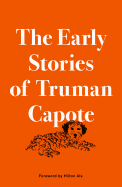
| Publisher: | Random House | |
| Genre: | Fiction, Short Stories (single author), Literary | |
| ISBN: | 9780812998221 | |
| Pub Date: | October 2015 | |
| Price: | $25 |
| Fiction |
by Truman Capote
The Early Stories of Truman Capote contains 14 stories, most previously unpublished, written in Capote's teens and 20s, and only recently unearthed among his papers in the New York Public Library archives. Presented with a foreword by Hilton Als of the New Yorker, these are short pieces, studies of subjects Capote would continue to favor in the later works for which he is known: sensitive young children, fractious ladies, the poor and the disenfranchised. They are set in the Deep South, in New York City, in swamps and in small towns.
The talents of the author of In Cold Blood and Breakfast at Tiffany are evident in this early work. His descriptions are simple but strongly evocative: "curly, wig-like grey hair" and eyes "bright, like bubbles of blue glass." His characters tend to be laconic but expressive, with interjections speaking as loudly as words. In "Swamp Terror," a boy chases a convict into the woods and gets a bigger taste of adulthood than he bargained for. In "Louise," a schoolgirl lets her petty jealousies do irreparable harm. "Traffic West" presents a remarkable collection of characters and events, in experimental form. In other stories, a young boy finds the dog of his dreams in a park, but the dog belongs to another child; and two wives muse on the hypothetical murder of their husbands.
These easy-reading, alternately amusing and haunting stories offer a fresh, new glimpse of Capote's genius, and simultaneously feel intimately familiar. --Julia Jenkins, librarian and blogger at pagesofjulia
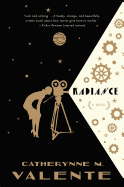
| Publisher: | Tor | |
| Genre: | General, Fiction, Science Fiction | |
| ISBN: | 9780765335296 | |
| Pub Date: | October 2015 | |
| Price: | $24.99 |
| Science Fiction & Fantasy |
by Catherynne M. Valente
Catherynne Valente's epic space odyssey Radiance bears resemblance to many a story of adventure, danger and voyages far from home: it centers on a beautiful woman. At the dawn of movies and interplanetary travel, the blue-skinned, mercurial Severin Unck is a beloved director, partner and daughter, and her disappearance during a shoot in a Venusian village is the spark that propels this novel into its suspenseful terrain.
Before the first sentence, Valente (The Girl Who Circumnavigated Fairyland in a Ship of Her Own Making) establishes a 100-year alternate-history timeline--from the first ship bound for space to Severin's father's attempts to eulogize his daughter in the 1960s. The deliberateness with which she navigates bloodlines, locations and films evokes García Márquez's One Hundred Years of Solitude, as does the prose, with lushness occasionally bordering on the flowery. Still, every character is enchanting, even minor players like aging soap opera star Violet El-Hashem. The empathetic cast ensures that the reader cares about more than just stars, both literal and cinematic; a subplot about whale-like beasts speared to extract callowmilk, which enables humans to live outside Earth, imbues the story with gravity other epics lack.
Dig through layers of talkies, love affairs and trips across the galaxy, and Radiance's pulse is its meditation on the stories we tell: Is anyone really the author of their own fate? Is there such thing as an ending, or even a clean beginning? When it comes to something this beautifully made, it's hard to protest when one story inevitably ebbs into another. --Linnie Greene, freelance writer
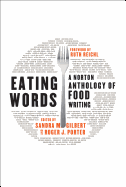
| Publisher: | W.W. Norton | |
| Genre: | Cooking, Essays & Narratives | |
| ISBN: | 9780393239843 | |
| Pub Date: | October 2015 | |
| Price: | $35 |
| Starred | Food & Wine |
by Sandra M. Gilbert and Roger J. Porter, editors
"Nature," said Plutarch, "disavows our eating of flesh." "Man," wrote Jean-Anthelme Brillat-Savarin, "...is omnivorous." "Eating is an agricultural act," says Wendell Berry. "The first spoonful of panna cotta is so startling," Diana Abu-Jaber recalls, "I want to laugh or sing or confess my sins. It tastes of sweetness and cream and even of the tiny early flowers the cows have eaten to make the cream."
The rich literature of passionate emotions, experiences and opinions about food is well represented in the new Norton anthology, Eating Words, edited by English professors Sandra M. Gilbert (The Culinary Imagination) and Roger J. Porter (Bureau of Missing Persons). Most of the writings sampled are from the 19th and 20th centuries, though 11 earlier ones go back as far as Leviticus.
Eating Words collects short works and excerpts of longer works, each with an informative headnote by the editors. Common themes include the pleasure of eating, the labor and enjoyment of cooking, and the emotional power of food. Authors argue for and against all kinds of dietary theories and practices. Others consider revulsion, privilege, poison, taboos or cannibalism. Some pieces focus on a single food or an extraordinary meal, as in Seamus Heaney's poem on eating oysters: "Our shells clacked on the plates,/ My tongue was a filling estuary,/ My palate hung with starlight." The breadth and depth of this anthology and the quality of the writing should appeal to anyone interested in food and its culture through the centuries. --Sara Catterall
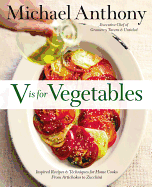
| Publisher: | Little, Brown | |
| Genre: | Vegetables, Specific Ingredients, Cooking, Vegetarian & Vegan | |
| ISBN: | 9780316373357 | |
| Pub Date: | October 2015 | |
| Price: | $40 |
| Food & Wine |
by Michael Anthony
Michael Anthony's inspiration behind V Is for Vegetables is found in the opening lines: "And here's what I believe: I celebrate local foods grown close to home; I like to share the backstory of the foods I cook, the people who grew them, where they're grown, and how they got to our kitchens." Although Anthony (executive chef at restaurants Gramercy Tavern and Untitled, and author of The Gramercy Tavern Cookbook) is a James Beard Award-winning chef, the recipes he presents in this cookbook are designed for all levels of ability "to share, not to show off."
As the title implies, Anthony's offerings are presented by ingredient, in alphabetical order, and highlight produce (vegetables, fruit, fungus, herbs and legumes). Anthony knows that in our meat-centric society, creating entrees out of vegetables can be daunting, so each ingredient is presented with identifying photographs, suggestions for preparation, and then recipes that showcase the ingredient, like Whole Stuffed Artichokes, Pan-Roasted Asparagus with Sunny-Side-Up Eggs, Carrot (or Chilled Corn) Soup with Coconut Milk, Braised Leeks & Yellow Lentils with Anchovy Dressing, Ramps and Spaghetti, and Stuffed Zucchini Blossoms with Sun Gold Tomato Sauce. The section on Herbs includes Parsley with Brown Butter Croutons, Chimichurri on Steak and Chive Matzoh Brei. While many of the vegetables are familiar (corn, iceberg lettuce, carrots, cucumber, cauliflower, broccoli, etc.), produce that could be intimidating to inexperienced cooks (artichokes, daikon, Jerusalem artichokes, rutabaga) are tamed with Anthony's clear explanations and tantalizing photographs. By the end, the entire alphabet is represented in a cornucopia of technicolor glory. --Kristen Galles from Book Club Classics

| Publisher: | Random House | |
| Genre: | General, History, Women's Studies, Biography & Autobiography, Social Science, Women, Social History, Personal Memoirs | |
| ISBN: | 9780679456209 | |
| Pub Date: | October 2015 | |
| Price: | $28 |
| Biography & Memoir |
by Gloria Steinem
Gloria Steinem, founder of New York and Ms. magazines and many women's organizations and a noted leader of the women's movement, shares her stories from along the way in My Life on the Road. As she sees it in hindsight, Steinem inherited a love for constant motion from her father, who lived for most of her life out of his car, with little Gloria keeping him company for her first 10 years. As a young woman not ready to settle down to marriage and motherhood, and then as an organizer, she kept moving. One chapter is dedicated to her choice to travel communally rather than use an automobile of her own, because it offers increased opportunities for contact.
My Life on the Road is not a history of the women's movement, although of course it contains many references to that history, as well as to the U.S. political climate and events of the second half of the 20th century. Instead, Steinem's memoir is a glimpse into one remarkable woman's life and philosophies of the road. It includes profiles of Steinem's immediate family and friends like Bella Abzug, Wilma Mankiller and Florynce Kennedy, and briefly addresses the conflict between Steinem and Betty Friedan. Steinem's writing style is personal, warm, approachable and straightforward. Her fans will be satisfied by this personal view, one that combines a love for people and places and stories and change with a love for movements--in both senses. --Julia Jenkins, librarian and blogger at pagesofjulia
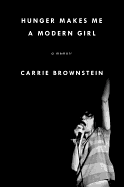
| Publisher: | Riverhead Books | |
| Genre: | General, Biography & Autobiography, Women, Composers & Musicians, Personal Memoirs | |
| ISBN: | 9781594486630 | |
| Pub Date: | October 2015 | |
| Price: | $27.95 |
| Biography & Memoir |
by Carrie Brownstein
As one third of the '90s alt-rock staple Sleater-Kinney and half of the creative team behind the hit show Portlandia, Carrie Brownstein has been a respected, if under the radar, force in pop culture for the last 20 years. On the heels of Sleater-Kinney's reunion, she's turned her sizable talents to autobiography. Hunger Makes Me a Modern Girl documents Brownstein's adolescence through the formation, then dissolution, of Sleater-Kinney, exploring her parents' broken marriage, her father's homosexuality and her own identity (sexual and otherwise). It also charts the rise of a rock band from the inside, eschewing typical stories of bacchanalia and artistic triumph in order to focus on how tough it is to create art, then tour across the world promoting it.
Hunger Makes Me a Modern Girl is best when discussing music, whether that's the genesis of some of Sleater-Kinney's songs or Brownstein's interest in Madonna at an early age. She brilliantly illustrates her working relationship with bandmates Corin Tucker and Janet Weiss, describing how her and Tucker's guitars work in unison and how Weiss's distinctive drumming grounds their sound. Readers can easily pick up a Sleater-Kinney album and understand exactly what Brownstein describes. The book is knowledgeable without being technical, and one does not need to know Brownstein's music to appreciate it. Unfortunately, not all of her writing works so well. Particularly when describing herself, she has a tendency to overwrite, providing three metaphors or adjectives when one would do. Still, even with some stylistic missteps, Hunger Makes Me a Modern Girl is an enlightening window into Brownstein's history and creative output. --Noah Cruickshank, marketing manager, Open Books, Chicago, Ill.
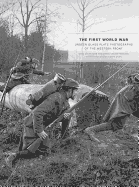
| Publisher: | University of Chicago Press | |
| Genre: | General, History, Europe, Pictorial, Military, Photography, World War I | |
| ISBN: | 9780226284286 | |
| Pub Date: | October 2015 | |
| Price: | $65 |
| History |
by Carl De Keyzer and David Van Reybrouck, editors
"Can the First World War still disturb us? Can a war that has been caught in pictures still affect us, dislocate us?" asks historian David Van Reybrouck in his introduction to The First World War: Unseen Glass Plate Photographs of the Western Front. This collection of 100 images, taken in Belgium and France during and shortly after World War I, answers with an unequivocal yes.
Glass plates do not suffer the same decay of detail inflicted on aging prints. Thus, with some minor restoration by Carl De Keyzer, the photographs in The First World War have, considering their age, an almost unreal clarity. Even details the photographers themselves meant to omit, like workers herded to the far edges of staged factory photos, or helpers holding up dead Belgian soldiers for identification, become visible on these massive pages. Many of the images are in color thanks to the autochrome process, in which glass plates were coated with potato starch. But, as Reybrouck writes, "the battlefields themselves remain monochrome, even in color."
For a collection chronicling an infamously bloody war, surprisingly few of the images are grisly. There are scenes with dead bodies--splayed in shell holes, posed for pictures, even a horse being autopsied--but the most dramatic photos show little violence: an armless veteran selling souvenirs in the ruins of Ypres, a soldier's wife and child beside his deathbed in an American hospital, French children staging mock executions. These pictures bring the war into the modern day, erasing the 100-year gap that disconnects us from historical horrors. --Tobias Mutter, freelance reviewer
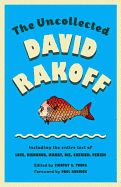
| Publisher: | Anchor | |
| Genre: | Literary Collections, Humor, Form, Canadian, Essays | |
| ISBN: | 9780307946478 | |
| Pub Date: | October 2015 | |
| Price: | $15.95 |
| Essays & Criticism |
by David Rakoff; edited by Timothy G. Young
Essayist, actor, humorist and frequent contributor to This American Life, David Rakoff (Half Empty) died in 2012, at age 47, after a public, on-again, off-again struggle with lymphatic cancer. But "what a fabulous accessory," he thinks after coaxing a beautiful man at a party to feel the pea-sized lump in his neck. In "My Sister of Perpetual Mercy," which opens The Uncollected David Rakoff, he is just 20 years old, working for a publisher in Tokyo, and must return home to Canada, where there await family, doctors, chemo treatment and the long journey toward recovery--none of it tolerable without the patience and care of his sister, Ruth.
Timothy G. Young has collected playful, friendly and touching essays Rakoff wrote over the years. In "The Love That Dare Not Squeak Its Name," written for Salon, Rakoff drolly queers the text of Stuart Little by suggesting that the boy who looked like a mouse seemed "somewhat like myself, pretty gay," with his tiny costumes and props, feeble and ill-fated love affairs, and iconic work as a sailor. Amid the heaping irreverence, the catharsis of the essay offers a tender look at what it can be like to grow up different.
Rakoff's strength has always been his sincere blend of humor and pathos, on brilliant display in his short novel Love, Dishonor, Marry, Die, Cherish, Perish, which is reproduced in its entirety here.
A heterogeneous collection of essays, journal entries, blog posts, radio transcripts and fiction, The Uncollected David Rakoff presents a full, shining complement from a jack of many trades. It's hard to accept that it will be the last. --Dave Wheeler, associate editor, Shelf Awareness
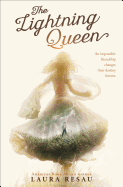
| Publisher: | Scholastic Press | |
| Genre: | People & Places, Friendship, Mexico, Social Issues, Juvenile Fiction | |
| ISBN: | 9780545800846 | |
| Pub Date: | October 2015 | |
| Price: | $16.99 |
| Starred | Children's & Young Adult |
by Laura Resau
Sparks fly when cultures collide in the fantastical, cross-generational novel The Lightning Queen by Laura Resau (Star in the Forest).
In the 1950s, on the Hill of Dust in rural Mexico, life takes an unexpected turn when a Roman--"Gypsy"--caravan rolls in. Enchanted by these colorful strangers, the Mixteco Indian villagers welcome the Romani and their "Traveling Cinema." Eleven-year old Teo is mourning his twin sister's death, but a girl who calls herself Esma, Gypsy Queen of Lightning, jolts the boy out of his grief. She crackles with the lightning she claims struck her--and Teo can feel it. Esma's grandmother Roza, the Mistress of Destiny, foretells that Teo and Esma will be loyal friends for life--and ultimately will save each other--but it's a longshot. Esma's people are nomadic, and her culture forbids friendship between boys and girls. Despite the odds, the unlikely pair sets out to prove that nothing is impossible. Bold Esme, who dreams of being a famous singer, is as determined as "the head of a lion" and Teo, a natural healer and friend to injured animals, lifts others up like "the wings of a bird." When the narrative shifts to the 21st century, an elderly Teo recounts their story for his grandson Mateo from Maryland, and it becomes clear the younger generation still has a role to play in Teo and Esma's destiny.
A celebration of culture and history, The Lightning Queen is a heartwarming, lyrical and inspiring tale of love, redemption and overcoming adversity. --Kyla Paterno, reviewer
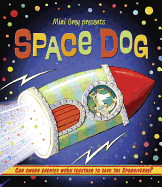
| Publisher: | Knopf | |
| Genre: | Animals, Mice, Hamsters, Guinea Pigs, etc., Imagination & Play, Cats, Dogs, Action & Adventure, Juvenile Fiction, Humorous Stories | |
| ISBN: | 9780553510584 | |
| Pub Date: | October 2015 | |
| Price: | $17.99 |
| Children's & Young Adult |
by Mini Grey
"Can sworn enemies work together to save the Spooniverse?" asks the cover of Space Dog. Yes, yes they can, in this giddy and hopeful outer-space adventure by British author-illustrator Mini Grey (Traction Man and the Beach Odyssey, Toys in Space, Hermelin: The Detective Mouse).
It's the year 3043 and it's time for Space Dog to go home after "a long mission sorting out planetary problems in the Dairy Quadrant," such as moving milk from a flooding planet to the dry and crunchy Cornflake 5. (Thanks, Straw People!) Just as Space Dog is safely back on the SS Kennel, he gets a distress call. A space ship has crashed into thick cream, but when he rescues the victim, it's a dreaded Astrocat! Astrocat takes a moment off from drowning to point out that Astrocats and Space Dogs are sworn enemies, but Space Dog says, "But there's no time for that now!" Aboard the ship, Astrocat and Space Dog get along swimmingly, playing Dogopoly and eating cake, until they get a call for help. It's coming from a planet that's "collapsing under the weight of its own cheesiness." And it's coming from a Moustronaut, yet another sworn enemy. They do the right thing, and in the end, the three adventurers set their controls for the "Unknown Zone" where they can all be "sworn friends."
Fans of Grey's Traction Man series will recognize the artful, turbo-charged spreads that explode with comic strip-style panels, expressive characters, hilarious cartoon-bubble asides, and so many details to chuckle over that repeat readings are required. --Karin Snelson, children's and YA editor, Shelf Awareness
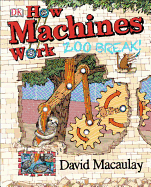
| Publisher: | DK | |
| Genre: | Juvenile Nonfiction, Machinery & Tools, Technology | |
| ISBN: | 9781465440129 | |
| Pub Date: | October 2015 | |
| Price: | $19.99 |
| Children's & Young Adult |
by David Macaulay
Necessity is the mother of invention... and sleepy Sloth and little Sengi, an elephant shrew, need to escape the confines of their zoo enclosure. The furry friends construct various scrappy but clever escape contraptions in this funny, interactive book by Caldecott artist David Macaulay (Black and White; The New Way Things Work).
How Machines Work: Zoo Break! lucidly explains the workings of simple machines in a delightfully elaborate way. Readers can peer into the clear plastic window of the cover itself and see a tunneling gear mechanism, then turn the gear to make the sloth go up and down. The first spread explores the efficiency of an inclined plane, as Sloth and Sengi stack a bunch of junk up against the zoo fence as a makeshift escape ramp. It might have worked, if Sengi's tail hadn't twitched, causing the napping sloth to swat him, causing the ramp to collapse! (A pop-up section reveals an angry zookeeper--he has to clean it up.) Each spread is a colorful visual feast of Macaulay's appealing pen-and-ink drawings, with insights into wedges, zippers, seesaws, catapults, levers, wheels, pulleys, cranes and more--all infused with the comical antics of Sloth and Sengi and at least one interactive element. Endearingly shameless puns abound, from "Living on the Wedge" to "A Wheely Bad Idea." Some of the escape attempts are quite nerve-wracking, such as when they try to pull down the fence using an upside-down cart, and the fence lands on Sengi.
This ingenious, entertaining, sturdily built book is sure to get the wheels turning for young engineers-in-the-works. --Karin Snelson, children's and YA editor, Shelf Awareness